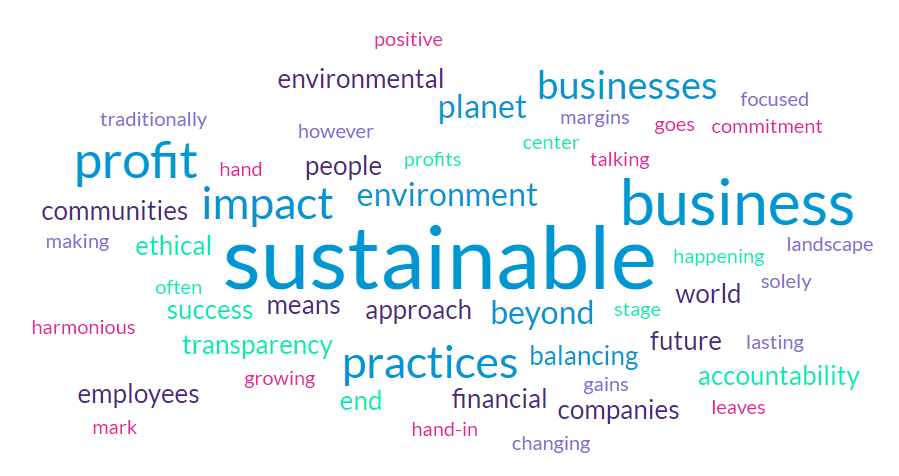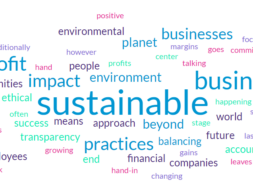Balancing Business Growth with Sustainability: How Businesses Can Be Profitable and Eco-Friendly

In today’s rapidly evolving business landscape, the balance between growth and sustainability has become a critical challenge for companies worldwide. While businesses aim to expand and maximize profits, they also face increasing pressure to operate in an environmentally responsible manner. Fortunately, sustainability and profitability are not mutually exclusive. In fact, many companies have proven that it’s possible to grow a thriving business while making a positive impact on the planet.
Why Sustainability Matters
Sustainability is no longer just a trend; it’s a necessity for businesses to remain competitive and relevant in the modern market. Consumers are increasingly eco-conscious and expect the brands they support to reflect those values. A 2023 study by Nielsen found that 73% of global consumers would definitely or probably change their consumption habits to reduce their environmental impact.
Beyond consumer preferences, governments and regulatory bodies are also implementing stricter environmental regulations. Non-compliance can result in hefty fines, damaging reputations, and reduced market opportunities. Businesses that prioritize sustainability can not only meet legal requirements but also build brand loyalty and a positive public image.
Moreover, sustainability can directly benefit a company’s bottom line. By optimizing resource use, reducing waste, and improving energy efficiency, companies can lower operational costs while enhancing long-term profitability.
The Intersection of Growth and Sustainability
Historically, businesses believed that achieving sustainability meant sacrificing growth. However, more and more companies are demonstrating that growth and sustainability can coexist. Brands like Patagonia, Unilever, and Tesla have pioneered sustainable business models while achieving impressive growth and profitability.
So, how can businesses strike this balance?
1. Adopt Renewable Energy
Transitioning to renewable energy sources such as solar, wind, or hydroelectric power can significantly reduce a company’s carbon footprint. Although the initial setup costs may be high, the long-term savings on energy bills make it a financially sound investment. In addition, renewable energy can protect businesses from fluctuating energy prices in the long run.
2. Implement a Circular Economy
A circular economy focuses on reusing, recycling, and regenerating materials throughout the production process. Rather than discarding products at the end of their life cycle, businesses can reintroduce these materials back into production. This reduces waste, cuts costs on raw materials, and aligns with sustainable practices. For example, brands like IKEA have committed to making all of their products from renewable or recycled materials by 2030.
3. Focus on Sustainable Packaging
Single-use plastics and non-biodegradable materials are among the leading contributors to environmental degradation. By adopting sustainable packaging, businesses can reduce waste, lower environmental impact, and appeal to eco-conscious consumers. The use of biodegradable, compostable, or reusable packaging materials is becoming an industry norm.
4. Partner with Sustainable Suppliers
Your business’s sustainability efforts should extend beyond internal operations. By working with suppliers who prioritize eco-friendly practices, you can ensure that sustainability is upheld throughout your entire supply chain. Whether it’s sourcing raw materials or outsourcing manufacturing, partnering with green suppliers strengthens your commitment to responsible business practices.
5. Invest in Energy-Efficient Technology
Energy efficiency is a cost-saving strategy that goes hand in hand with sustainability. By investing in energy-efficient appliances, lighting, and heating systems, businesses can significantly reduce their energy consumption. In addition, technologies like smart sensors and automation systems can optimize energy use, leading to further savings.
Practical Tips for Entrepreneurs to Balance Growth and Sustainability
For entrepreneurs and small business owners, the path to balancing growth with sustainability can seem daunting, especially with limited resources. However, implementing small, incremental changes can make a big difference over time. Here are a few practical tips:
- Start small: Begin by making manageable changes such as switching to energy-efficient lighting, reducing water consumption, or using recycled materials for packaging.
- Educate your team: Sustainability should be a collective effort. Ensure that your team is on board and understands the importance of eco-friendly practices.
- Measure your impact: Track your environmental footprint and set goals to continuously improve your sustainability efforts. Use metrics such as energy usage, waste production, and carbon emissions to monitor progress.
- Build a sustainable brand story: Consumers resonate with companies that have a clear mission and purpose. Share your sustainability journey and demonstrate how your business is making a positive impact on the environment.
Conclusion: Growth Through Sustainability
Balancing business growth with sustainability is not only achievable but also crucial for long-term success. As consumer expectations and regulations evolve, businesses that prioritize eco-friendly practices will position themselves as leaders in their industries. By adopting sustainable strategies, companies can reduce costs, enhance their reputation, and build a loyal customer base, all while contributing to a healthier planet.
Whether you’re a startup or a well-established company, embracing sustainability can help you grow in a responsible, profitable, and future-ready way.
#SustainableBusiness #EcoFriendlyGrowth #GreenEntrepreneurship #SustainableProfit #BusinessTips #EcoConscious #EntrepreneurLife #SaveThePlanet #CircularEconomy #RenewableEnergy #BaobabEntrepreneur #SmallBusinessGrowth #BusinessInnovation #Entrepreneurship
















